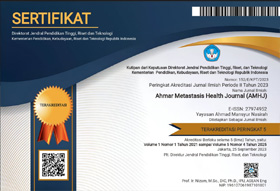The Impact of Nutrition Education Using the "My Plate Model with Local Food Nutrition Cards" Mikuzikal Tool on Maternal Knowledge for Stunting Prevention
DOI:
https://doi.org/10.53770/amhj.v4i3.420Kata Kunci:
Stunting, Nutritional Education, MIKUZIKAL, Mothers' Knowledge, Community Health CenterAbstrak
Stunting is a serious health issue in Indonesia, with a national prevalence of 27.7% in 2022. West Sulawesi ranks as the second-highest province with a prevalence rate of 35%, while in Mamuju Regency, the prevalence reaches 27.45%. Nutritional education is one of the strategies to improve mothers' knowledge in preventing stunting. This study aims to analyze the effect of nutritional education using the MIKUZIKAL tool ("My Plate Model with Local Food Nutrition Cards") on the knowledge of mothers with children aged 2-5 years in the working area of Puskesmas Bambu, Mamuju Regency. This study employs a quasi-experimental design with a one-group pretest-posttest approach. A total of 54 mothers with young children were selected as research subjects using the total sampling method. Data were collected through questionnaires and analyzed using the Wilcoxon sign rank test. The results show that 35 respondents (64.8%) experienced an increase in post-test scores, 13 respondents (24.1%) experienced a decrease, and 7 respondents (11.1%) had unchanged scores. Statistical analysis revealed a significant difference before and after the intervention (p = 0.001). In conclusion, nutritional education using MIKUZIKAL positively influences the improvement of mothers' knowledge in preventing stunting. Therefore, this method can be recommended as an educational strategy in healthcare facilities to address stunting issues.
Referensi
Al Maajid, P., Antono, S.D., Cahyani, D.D., & Kundarti, F.I. (2024). Hubungan Pengetahuan Ibu Tentang Isi Piringku dengan Kejadian Stunting Balita Usia 24-35 Bulan. Jurnal Ilmu Kesehatan, 13(1), 6 - 14. https://doi.org/10.32831/jik.v13i1.709
Aswi, A., Rahardiantoro, S., Kurnia, A., Sartono, B., Handayani, D., Nurwan, N., & Cramb, S. (2024). Childhood stunting in Indonesia: assessing the performance of Bayesian spatial conditional autoregressive models. Geospatial health, 19, 1321. https://doi.org/10.4081/gh.2024.1321
Ayu, R. N. S., & Surahman, N. (2023). Sosialisasi “Isi Piringku” Sebagai Pencegahan Stunting Di Raudlatul Athfal Tanwirut Tulab Payung Makmur Lampung Tengah. EJOIN: Jurnal Pengabdian Masyarakat, 1(12), 1372-1376. https://doi.org/10.55681/ejoin.v1i12.1922
Bundala, N., Kinabo, J., Jumbe, T., Bonatti, M., Rybak, C., & Sieber, S. (2020). Gaps in knowledge and practice on dietary consumption among rural farming households; a call for nutrition education training in Tanzania. International journal of food sciences and nutrition, 71(3), 341–351. https://doi.org/10.1080/09637486.2019.1655533
Dermawan, A., Mahanim, M., & Siregar, N. (2022). Upaya percepatan penurunan stunting di kabupaten asahan. Jurnal Bangun Abdimas, 1(2), 98-104. https://doi.org/10.56854/ba.v1i2.124
Evawaty, N. J., Hidayanty, H., Natsir, S., Thaha, R., Amiruddin, R., Citrakesumasari, L. W., ... & Thalib, A. (2023). Stunting Prevention By Strengthening Posyandu And Family Approach Through Health Literacy In Majene Regency, West Sulawesi Province. Chelonian Research Foundation, 18(2), 917-929. Retrieved from http://www.acgpublishing.com/index.php/CCB/article/view/78
Fadare O, Amare M, Mavrotas G, Akerele D, & Ogunniyi A. (2019). Mother’s nutrition-related knowledge and child nutrition outcomes: Empirical evidence from Nigeria. PLoS ONE, 14(4), e0215110. https://doi.org/10.1371/journal.pone.0215110.
Girma, S., Fikadu, T., & Abdisa, E. (2019). Maternal Common Mental Disorder as Predictors of Stunting among Children Aged 6-59 Months in Western Ethiopia: A Case-Control Study. International journal of pediatrics, 2019, 4716482. https://doi.org/10.1155/2019/4716482
Idealistiana, L., & Farlikhatun, L. (2020). Efektivitas Kartu Pintar Cegah Stunting Terhadap Peningkatan Pengetahuan Ibu Hamil Tentang Stunting di Wilayah Jakarta Timur Tahun 2020. Jurnal Antara Kebidanan, 3(4), 1051-1062. https://doi.org/10.37063/jurnalantarakebidanan.v3i4.290
Kementerian Kesehatan Republik Indonesia. (2022). Buku Saku Hasil Survei Status Gizi Indonesia (SSGI) 2022. Jakarta: Kementerian Kesehatan Republik Indonesia.
Kiik, S. M., & Nuwa, M. S. (2020). Stunting dengan pendekatan Framework WHO. Bantul: CV. Gerbang Media Aksara
Komarulzaman, A., Andoyo, R., Anna, Z., Ghina, A. A., Halim, P. R., Napitupulu, H., ... & Andriani, A. (2023). Achieving zero stunting: a sustainable development goal interlinkage approach at district level. Sustainability, 15(11), 8890. https://doi.org/10.3390/su15118890
Masyithoh, D. N., & Kuswandi, A. (2023). Implementasi Kebijakan Tentang Percepatan Penurunan Stunting di Posyandu Dahlia 10 Desa Burangkeng Kecamatan Setu Kabupaten Bekasi. VILLAGE: Journal Rural Development And Goverment Studies, 3(1), 13-21. Retrieved from: https://journal.umpo.ac.id/index.php/village/article/view/10124
Pitoyo, A. J., Saputri, A., Agustina, R. E., & Handayani, T. (2022). Analysis of determinan of stunting prevalence among stunted toddlers in Indonesia. Populasi, 30(1), 36.
Ramadhiani, A. R., Paradilawati, C.Y., & Widyasari, W. (2023). Pengaruh Pemberian Edukasi Terhadap Pengetahuan Masyarakat Tentang DAGUSIBU (Dapatkan, Gunakan, Simpan Dan Buang) Obat di Desa Kerujon. Majalah Farmaseutik, 19(1), 48-54. https://doi.org/10.22146/farmaseutik.v19i1.73424
Sani, Y. M., Hariyoko, Y., & Basyar, M. R. (2024). Evaluating the Effectiveness of Community Participation in Stunting Reduction in Surabaya. Jurnal Mengkaji Indonesia, 3(2), 267-286. https://doi.org/10.59066/jmi.v3i2.794
St.Hasriani, Pratiwi, W. R., & Asnuddin, A. (2023). Cegah Balita Dari Stunting Melalui Edukasi Isi Piringku Di Posyandu Cempaka Kabupatten Barru. Jurnal Altifani Penelitian Dan Pengabdian Kepada Masyarakat, 3(3), 450–456. https://doi.org/10.59395/altifani.v3i3.404
Suryana, E. A., & Azis, M. (2023). The potential of economic loss due to stunting in indonesia. Jurnal Ekonomi Kesehatan Indonesia, 8(1), 52-65.
Syafrawati, S., Lipoeto, N. I., Masrul, M., Novianti, N., Gusnedi, G., Susilowati, A., ... & Umar, H. B. (2023). Factors driving and inhibiting stunting reduction acceleration programs at district level: A qualitative study in West Sumatra. Plos One, 18(3), e0283739. https://doi.org/10.1371/journal.pone.0283739
WHO. (2014). Global Nutrition Targets 2025 policy Brief Series. WHO. Retrieved from: https://www.who.int/publications/i/item/WHO-NMH-NHD-14.2
WHO. (2024). Ibu Membutuhkan Lebih Banyak Dukungan Menyusui Selama Masa Kritis Bayi Baru Lahir. WHO. Retrieved from: World Health Organization website: https://www.who.int/indonesia/id/news/detail/01-08-2024-mothers-need-more-breastfeeding-support-during-critical-newborn-period
Unduhan
Diterbitkan
Cara Mengutip
Terbitan
Bagian
Lisensi
Hak Cipta (c) 2024 Ahmar Metastasis Health Journal

Artikel ini berlisensiCreative Commons Attribution-ShareAlike 4.0 International License.






